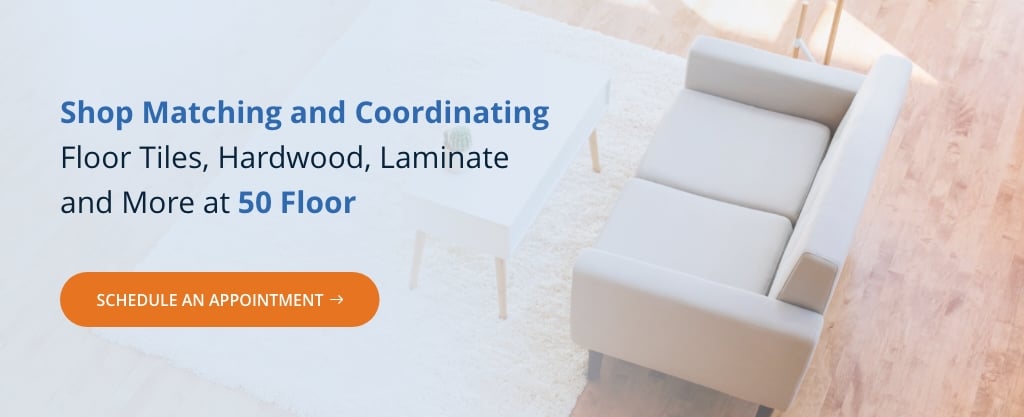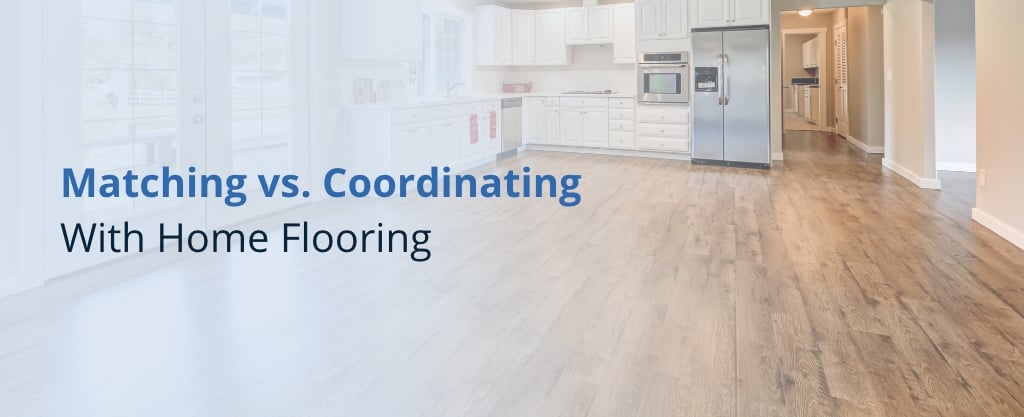

Are you about to start the journey of redecorating your home? While this exciting process lets you experiment with new colors, textures, and patterns it also lets you find new ways to explore your personality and express yourself through your own surroundings. There are so many different avenues to let your tastes shine when it comes to decorating — from the paint and furniture to the lighting and, of course, matching vs. coordinating flooring.
For the best results when decorating, you’ll likely need to follow a design theme. After all, you might love green, purple, and yellow, but if all three colors are used on your walls, you’ll probably be left with a disjointed appearance that is the opposite of aesthetically pleasing.
Why? Because this color grouping goes against two essential design and decor work principles: matching and coordinating. While these two ideas are similar, they’re still independent principles. However, when used together, they can help you create a beautiful, unique home that expresses your personality without looking like a random color explosion.
The concept of matching or coordinating is not just for furnishings and wall decor — it also relates to flooring. Our guide below will show you how to properly match or coordinate your home’s flooring to give your home the best possible look.
Matching vs. Coordinating
We all understand the idea of matching — the idea that like goes with like. Think of matching the way you might think of a pair of shoes or mittens. The right and the left are absolutely identical and belong together as a pair. They match with one another.
Coordinating is similar to matching, but there’s a distinct difference: two elements may not be identical, yet they still work harmoniously. Perhaps they share the same color but differ in shape, or vice versa. Think of it like pairing shoes with an outfit — your footwear isn’t an exact “match” to your dress or shirt, but it complements and highlights certain features. That synergy is what we mean by “coordinating.”
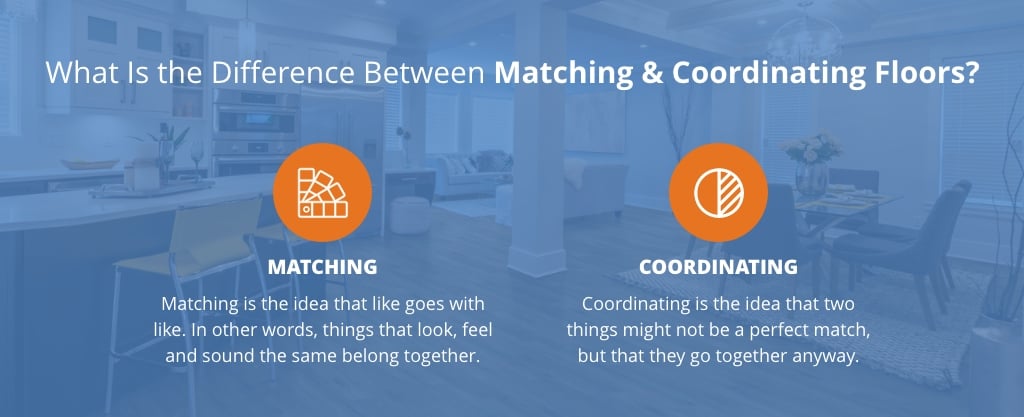

What Is the Difference Between Matching and Coordinating Floors?
With this basic understanding of matching and coordinating, let’s apply this concept to flooring. Based on what we’ve established, matching floors would be a situation where every flooring in your house was exactly the same. For example, if you had hardwood flooring in your living room, matching hardwood floors would mean carrying the same hardwood into the dining room, and then into the kitchen, and so on.
Coordinating floors is different. Maybe this means that your living room floor is a deep, dark wood color, but your dining room can be a shade lighter that is different but still complements the living room shade. Maybe the hall can be carpeted, in a warm shade that harmonizes well with the earth tones in your various wood grains. In this way, coordinating floors aren’t afraid to avoid perfect matches. Coordinating floors give you more freedom to explore new colors, textures and designs, all while still creating something that looks beautiful together as a whole.
Should Flooring Be the Same Throughout the House?
Many homeowners opt for the same flooring throughout their homes to create a clean, seamless look. Others prefer to mix and match flooring for a unique, more functional design.
Both choices have their advantages. Uniform flooring is often cheaper, simplifies cleaning, and unifies the home’s design. However, it can feel monotonous from a style perspective.
Varied flooring, on the other hand, can make repairs more affordable and easier. Plus, you can tailor materials to each room’s needs—waterproof and humidity-resistant flooring in kitchens and bathrooms, for instance, and softer surfaces in bedrooms. The drawback is that using multiple types of flooring can break up the home’s overall flow, making it feel less open.
Ultimately, whether you choose one type of flooring or mix and match depends on your preferences and the needs of each space.


Floor Matching vs. Coordinating: Which One Is Right for Me?
Should your flooring be the same throughout the house? There’s no right or wrong answer; it’s a simple matter of taste.
If you absolutely love a particular floor and want to install it throughout your entire house, go for it! If you like mixing things up and trying different flooring styles, no one will bat an eye at that either.
Whether you want to try mixing and matching different styles that coordinate or simply stick with the process of floor matching, go with what you’re comfortable with. At the end of the day, matching and coordinating are great tools to have in your decorator’s arsenal, and both can be the “right” decision.
Schedule Your In-Home Consultation
How to Match Flooring: 4 Tips for Matching Flooring Throughout Your House
Should wood floors match throughout the house? Is it better for laminate to be the same color throughout the entryway, dining room, and kitchen? And what about tile?
Below are our top tips for seamlessly matching flooring from one space to the next.
1. Make Sure It’s an Exact Match
There’s nothing wrong with using the same flooring throughout your home, and there’s nothing wrong with mixing different floor types. However, avoid choosing two that are almost identical but not quite the same. If you’re trying to match existing flooring, find an exact match rather than a close look-alike. Otherwise, the slight mismatch will always catch your eye, breaking the seamless flow and drawing attention to where the flooring changes.
You might think it’s too small to notice, but subtle differences become glaring when they cover an entire room. If you can’t find an exact match, opt for something obviously different yet coordinated instead of a near-match that just misses the mark.
2. Take Pictures or a Sample
Matching an existing floor in your house can be tricky. Ideally, it will be a floor you installed yourself only a few years ago, so you can go back to the same manufacturer or sales company and order more of the same. Unfortunately, this isn’t always the case.
Sometimes, it’s a floor that’s been discontinued since you installed it years ago or perhaps a floor that someone else installed in a home you’re just now moving into. In each scenario, you don’t have the luxury of simply placing another order with the same company. For these situations, try taking a sample of the old floor with you to match it as closely as possible.
If this isn’t possible, bring a picture. Try to take the picture in bright, natural daylight, and clean the floor first to get a more accurate match.
Many flooring companies will provide samples for you to take home and compare against your existing flooring. This is usually the best solution, and you should absolutely take advantage of it if it is offered.
3. Write Down a Few Notes
There are a few key factors you want to keep in mind when figuring out how to match your existing hardwood floors, such as:
- Type and species of wood. Wood floor types range from oak to hickory to maple. Ensure you know exactly what type of wood floor you have installed in your home. Once you know the wood type, note what species you have as well. For example, oak hardwood floors are in many homes, but oak can come in two different species: red oak and white oak. Likewise, maple comes in hard maple and black maple species.
- Grade of wood. There are several different grades of wood, but these three are most commonly used for flooring: Select, #1 Common, and #2 Common. Select is the highest grade of the three, while #2 Common is the lowest. However, the grade doesn’t tell you how durable or high-quality your floors are — it describes the number of clear pieces the wood can be cut into.
- Color. Matching the color of existing hardwood floors might seem straightforward, but wood color is rarely static. Many species darken or change hue over time — Brazilian cherry, for example, can develop a deeper red tone as it ages. Daily wear and tear, stains, and waxing also alter a floor’s shade. Even if you match the type, species, and grain perfectly, an older floor may look noticeably different from a brand-new one. Custom stain blends further complicate the process, making it difficult to recreate an exact color match.
- Width. To ensure a seamless look, accurately measure the width of your current floorboards using a ruler or tape measure. Remember that older homes, especially those with Douglas fir floors, may have non-standard widths requiring custom milling.
- Thickness and height of the flooring. Last but not least, check the thickness and height of your current wood floors. The standard is 3/4 inches thick, but ensure any new pieces are consistent with the existing floor.
4. Start From Scratch
Achieving a perfect match can be challenging when working with older or pre-existing floors. You might get lucky, but more often than not, it’s difficult to find the exact style or color. If you’re determined to match your existing hardwood floors, consider stripping the current floor, finding the closest match, and refinishing both at the same time. Stripping creates a “blank slate,” while refinishing them together helps align the color and finish.
Sometimes, you may have no choice but to remove the old flooring and start from scratch. In that case, pick a new material similar in design, color, and style to the original, and buy enough to cover every area you plan to replace. This is the best way to ensure a truly uniform look.
5 Tips for Coordinating Flooring Throughout Your Home
Have you decided to go with coordinated flooring options for your house? This process can be fun and rewarding for many, but how exactly do you know when one flooring option works with another? Is there a way to know, or is it purely subjective?
To help you navigate this process, here are our best tips for coordinating flooring schemes in your house.


1. Fit the Room Itself
Certain rooms in your home naturally lend themselves to different types of flooring. For example, natural stone or wood flooring works well in an open family space like the kitchen, dining room, or living room. Soft carpet flooring can help turn a basement from a drafty storage space to a welcoming family room.
Think about what mood you’re trying to achieve with each room and what you commonly see laid in rooms of this type — then move forward from there.
2. Be Careful Where You Switch Flooring
Avoid switching up the flooring in the middle of an open space. One room shouldn’t have two different types of flooring. Instead, make the boundaries between your different floors fit naturally along the borders between the two rooms.
If there’s a natural divide where your kitchen fades into your dining room, it’s an appropriate place to transition. Perhaps the carpet in the hall could fade into the hardwood of your bedroom directly underneath the bedroom door. Search for these natural barriers and use them to your advantage.
Another great way to minimize the abruptness of this transition is moldings, which can help create a natural transition from one floor to the next. Moldings come in wide varieties and may be just the thing to create a smoother balance between your coordinating floors.
3. Pay Attention to Color
Color is vital in creating a sense of continuity as your house blends from one floor to the next. If you have a deep, dark carpet in one room, it may be best to avoid placing it directly up against a gleaming white marble in the next room. If the carpet in the hallway is dark red, you may not want to contrast it with a green carpet in the bedroom.
However, you will likely have better success if you use that same red carpet upstairs but put the green carpet in the basement instead. By creating distance, you allow each color to shine on its own instead of simply creating a color clash.
4. Stick With Less Than Three Different Types of Flooring
No, we don’t mean you have to have less than three different floorings in the house. Rather, we suggest keeping it to a maximum of two at any given junction of floorings.
Imagine an intersection in your house, such as where the dining room, living room, and hall all join together. If each of these three spaces has its own unique flooring, there will inevitably be this place where those different floors meet. By having three different floorings set directly against one another, you’re creating a very busy space that’s difficult to take in all at once.
It will be almost hard to look at — cluttered and over-crowded — even if the space is totally empty. Instead, try to stick to a meeting of only two coordinating floors. This will be less jarring to the eye and help the space look less stuffed with too many colors and textures.
5. Think About More Than Floors
One of the best ways to coordinate your flooring is to consider the rest of the room. Think about the color of the paint on the walls and the color of your sofas. What about your kitchen cabinets? Drawing inspiration from these other colors and patterns creates a room that looks complete and cohesive.
In most cases, when your room appears put together in this way, no one will even notice if the two floorings next to each other don’t “match.” Do floors need to match your countertops or other fixtures exactly? No. Instead, try to coordinate with them in the same way you would coordinate with the other floors. This goes a long way toward creating a well-balanced and well-designed space.
4 Mistakes to Avoid When Coordinating Flooring in Your Home
Coordinating floors in your residential space will require you to consider what you hope your living spaces will look like once your project is complete. Generally, there are a few mistakes you should avoid when reimagining your home:


1. Getting Out of Hand With Color Variations
Think about your home’s main features. These elements could be furniture, cabinets, doors, or picture frames. When coordinating hard surfaces like wood floors, you’ll want to choose complementary colors that suit the rest of your decor. Choosing too many colors for your home can result in a confusing or unbalanced appearance.
2. Changing Colors from Room to Room
Placing different flooring in each room can lead you to endless combination options. Remember to keep your selections consistent if you’re a fan of treading on soft carpets in bedrooms. Finding one carpet shade that works for your residential spaces and using it in all carpeted rooms is ideal for creating a cohesive space. Instead of changing the flooring in every room, you can differentiate various bedrooms and other spaces by changing their paint colors.
3. Putting Carpet Where You Eat
Carpets feel luxurious under your feet in clean spaces, but it’s best to keep these materials away from kitchens and dining rooms. Think about where you’re most prone to spills and drops. Consider coordinating hardwood floors in these locations to make surfaces easier to clean.
4. Trying to Create Contrast
Coordinating the flooring for a room involves picking a surface color that complements the rest of your space. Look for options that complement other flooring, paint colors, or wall decor across multiple areas. Switching between light and dark shades throughout your home can result in abrupt transitions.
Common Flooring Questions
The flooring in your home can have a huge impact on functionality and design, so it’s important to take your time to choose the right option. Here are some of the most frequently asked questions about matching and coordinating flooring.
How Do You Match Laminate Flooring?
If you’re trying to match laminate flooring to other laminate flooring, look at the tone of your existing floor. The sun likely changed your flooring from its original look, so try to identify the true tone of your flooring and not the shade it was during purchase.
Once you identify the tone, bring home samples of laminate flooring in the same color family to see which material looks the most similar. You may not be able to find a perfect match, but rugs and furniture can help your flooring blend together, creating the illusion of an identical match.
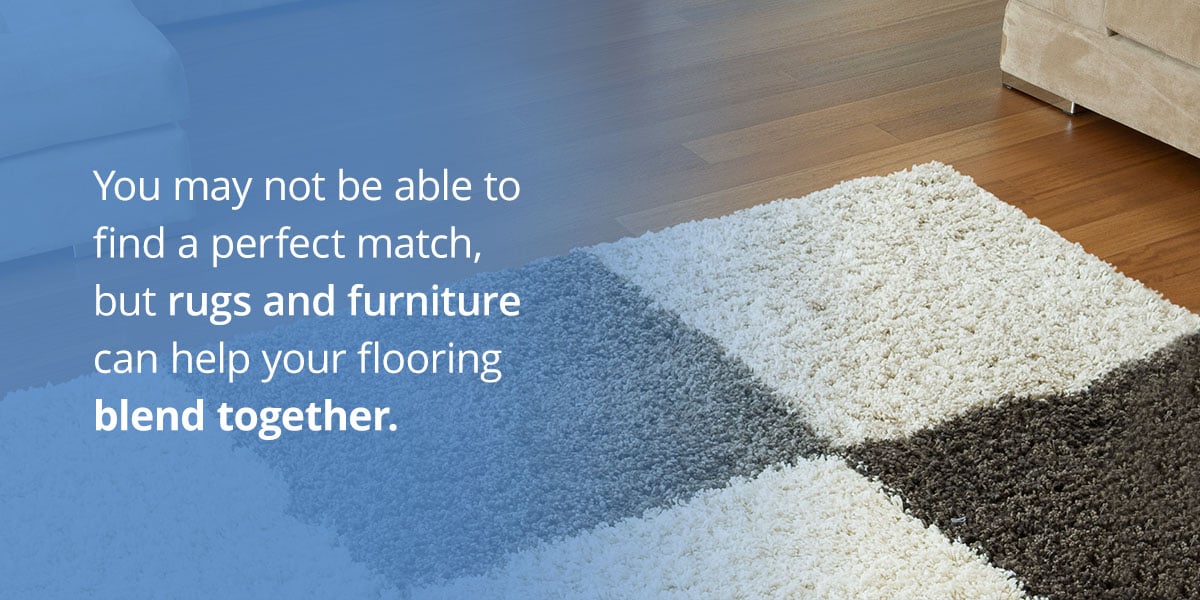

Should Hardwood Floors Match Throughout the House?
Most designers will tell you that your hardwood floors should ideally match or coordinate throughout your house. However, using matching flooring is ultimately a personal choice, and there is no right or wrong answer.
With hardwood flooring, you can mix and match different colored hardwood floors in adjacent rooms. These color variations in your hardwood can be as subtle or drastic as you want.
Matching flooring is often recommended because it creates a seamless finish and better flow throughout your home. However, when it comes to interior design rules for flooring, there are no hard rules — if you like mixing flooring or think your interior design could benefit from it, just go for it.
How Do You Match Hardwood Floors to Laminate?
Hardwood and laminate flooring are trickier to pair together. They will never match perfectly, but they can coordinate. You’ll want to find complimentary undertones and similar wood grains. A transition board is a key aspect of getting these two flooring materials to work together.
The transition board separates the two materials and allows us to see them as two complementary floors instead of one poorly matched continuous floor. If you don’t enjoy the look of a transition board, consider a rug to help blur and blend the transition.
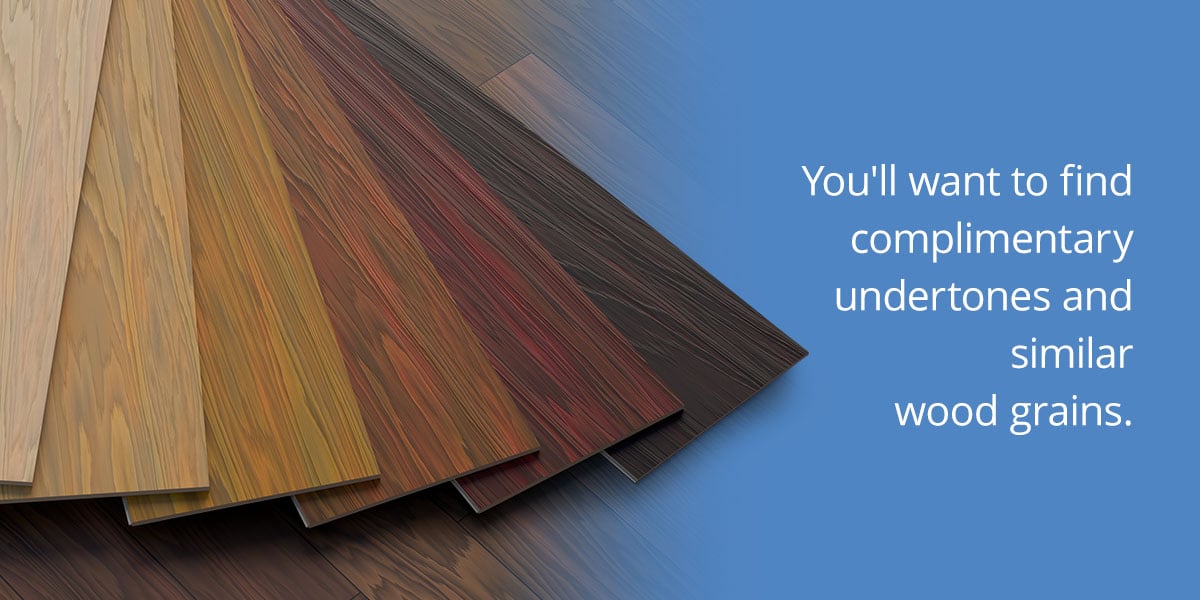

Should Tile Match Throughout the House?
Similar to hardwood flooring, it’s up to you and your design preferences whether to match tile flooring throughout your home. If you choose to mix your flooring, try to select no more than three options — this gives you variety while still keeping a cohesive design.
How Can You Mix Flooring Types In-Home?
If you want to incorporate different floor types in your home, try choosing a flooring material for each room category to give you variation and consistency. Perhaps you opt for hardwood flooring in your living spaces, carpet in the bedrooms, and tile in the bathrooms. The consistent and uniform use of materials will make your home feel seamlessly connected.
Shop Matching and Coordinating Floor Luxury Vinyl Tiles, Hardwood, Laminate and More at 50Floor
Are you looking to create a seamlessly designed home using matching or coordinating floors?
First, you’ll need to find a flooring company that offers a wide range of colors, styles, and materials. 50Floor is your destination for all things flooring. We understand that it can be challenging to envision how flooring will look in your home while viewing samples in a showroom. That’s why we bring our samples to you so you can compare different flooring options to your current flooring in real-time.
Because lighting can significantly change a floor’s appearance, it’s best to compare samples under your home’s actual lighting conditions to see how well they coordinate or match your existing floors. When you schedule an at-home consultation with our trained floor experts, you receive expert guidance and assistance while we walk you through things like our installation processes, do’s and don’ts for flooring, and any other questions that might be on your mind during the shopping process.
For more information and to get started shopping for the right flooring for you, call us at (877) 722-8760 or schedule an appointment today.





